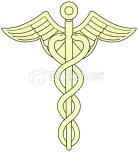Medical Logo Change
When I saw that the logo of the AMA had been changed, I was very disturbed by it because it indicates a change in mission. Since I was researching health care "reform" and the integration of medical research into daily medical practice, truth be told, I was horrified. I sent an inquiry to the AMA asking for an explanation for the change.

Caduceus
Aesculapius
The single-serpent staff of Aesculapius is the symbol of choice by scholars and those in the medical profession. It historically has represented the power and mystery of the healing art and of the compassion and devotion of the healer.
The AMA symbol or staff of Aesculapius is one serpent around a staff. However there is also the Caduceus which is two serpents around a staff.
The caduceus, which was not used to represent medicine until after 1800, is the twin-serpent magic wand of Hermes. The word caduceus is derived from a Greek root meaning "herald's wand." and the Romans were said to have used the caduceus as a badge of neutrality among heralds seeking peaceful negotiations with the enemy.
While Caducei of Egypt, representing medicine, have been found on vases from around 2400 BC, widespread use of the Greek/Roman caduceus was not associated with medicine until the 16 century, when Sir William Butts, physician to Henry VIII, was granted use of it for his professional crest. At that time, some book publisher (medical and otherwise) also adopted it, but scholars agree their use of it was not for its medical meaning but for its communication connotations.
The beginning of the use of the caduceus as a medical symbol in the United States dates back to 1856, when it was selected by the US Marine Hospital Service to designate the noncombatant nature of the medical corps. The Surgeon General's crest of 1818, which was designed for this purpose and contained the single-snake staff of Aesculapius, was somehow ignored. This omission was compounded in 1871, when the caduceus became the symbol of the Public Health Service, and in 1902, when it was adopted by the US Army Medical Corps.
The popularity of the caduceus today is probably attributable to its being more aesthetically appealing than the staff of Aesculapius. The symmetry of the wings atop a staff and the double snakes is more balanced than the staff and single snake of Aesculapius.
Purists, however, fervently profess and staunchly defend the staff of Aesculapius, emphasizing that from its inception it has represented the ideals of medicine.
There is a general agreement among scholars that the snake, whether it is one or two around a staff, is an appropriate symbol for the healing art. In addition to representing wisdom, learning, and fertility, it stands for longevity and the restoration of health. The snake, after all, appears to regenerate by shedding it skin, thereby assuming a new life. The serpent also was considered a potent force against disease and was thought to protect children from epidemics if they touched its skin.
Sincerely,
Monica Reyna
Communications Coordinator American Medical Association
